
The Lincoln Memorial is a US national memorial built to honor the 16th president of the United States, Abraham Lincoln. It is on the western end of the National Mall in Washington, D.C., across from the Washington Monument, and is in the form of a neoclassical temple. The memorial's architect was Henry Bacon. The designer of the memorial interior's large central statue, Abraham Lincoln (1920), was Daniel Chester French; the Lincoln statue was carved by the Piccirilli brothers. The painter of the interior murals was Jules Guerin, and the epithet above the statue was written by Royal Cortissoz. Dedicated in May 1922, it is one of several memorials built to honor an American president. It has always been a major tourist attraction and since the 1930s has sometimes been a symbolic center focused on race relations.
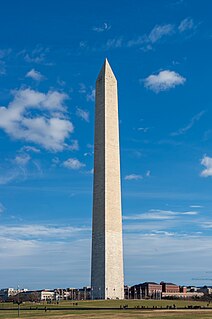
The Washington Monument is an obelisk within the National Mall in Washington, D.C., built to commemorate George Washington, once commander-in-chief of the Continental Army (1775–1784) in the American Revolutionary War and the first President of the United States (1789–1797). Located almost due east of the Reflecting Pool and the Lincoln Memorial, the monument, made of marble, granite, and bluestone gneiss, is both the world's tallest predominantly stone structure and the world's tallest obelisk, standing 554 feet 7+11⁄32 inches (169.046 m) tall according to the U.S. National Geodetic Survey or 555 feet 5+1⁄8 inches (169.294 m) tall, according to the National Park Service. It is the tallest monumental column in the world if all are measured above their pedestrian entrances. Overtaking the Cologne Cathedral, it was the tallest structure in the world between 1884 and 1889, after which it was overtaken by the Eiffel Tower in Paris.

Navajo Bridge is the name of twin steel spandrel arch bridges that cross the Colorado River in the Grand Canyon National Park in northern Coconino County, Arizona, United States. The newer of the two spans carries vehicular traffic on U.S. Route 89A (US 89A) over Marble Canyon between Bitter Springs and Jacob Lake, allowing travel into a remote Arizona Strip region north of the Colorado River including the North Rim of Grand Canyon National Park.

The Civil War Memorial, in the DeKalb County county seat of Sycamore, Illinois, United States, is located in front of the DeKalb County Courthouse on a public square. The memorial was erected in 1896 and dedicated in 1897. The structure is a memorial to the thousands of DeKalb County residents who served in the American Civil War. It incorporates an obelisk which rises to 50 feet in height. The base is adorned with copper sculpture, completed by an unknown sculptor. On the east facade of the memorial the word "Antietam", denoting the Battle of Antietam, is misspelled. This work of public art underwent its first restoration work in 2005-2006.
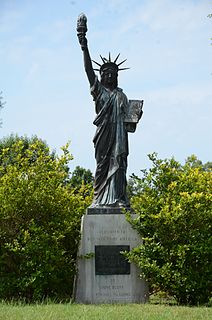
The Strengthen the Arm of Liberty Monument is a replica of the Statue of Liberty in Pine Bluff Memorial Gardens, on the south side of 10th Avenue between Georgia and State Street in Pine Bluff, Arkansas. It was placed by the Boy Scouts of America (BSA) as part of its 1950s era campaign, "Strengthen the Arm of Liberty." The statue is 8 feet (2.4 m) in height, made of copper, and is mounted on concrete base 3.5 feet (1.1 m) tall. The statue faces north, toward the Pine Bluff Civic Center, and there is a bronze commemorative plaque on the north face of the base. It is one of two BSA-placed statues in the state; the other is in Fayetteville.

Herman Davis State Park is a 1-acre (0.40 ha) state park in Manila, Arkansas, United States. The park includes the grave of and a memorial to Herman Davis (1888-1923), a U.S. sniper during World War I. The park is located at the junction of Baltimore Avenue and Arkansas Highway 18, south of the city center. It consists of a grassy area, with a concrete walk leading to the memorial. The memorial is a granite obelisk, 25 feet (7.6 m) in height, in front of which stands a full-size granite likeness of Davis in his infantry uniform. Davis' remains are buried just behind the monument. The site is the only location in Arkansas associated with Davis, a native of Manila who won distinction in the war for taking out a nest of German machine gunners with his marksmanship. Davis modestly rarely mentioned the awards he received for this and other actions, but was called out by General John J. Pershing, who placed him fourth on a list of 100 heroes of the war.

Major General George Henry Thomas, also known as the Thomas Circle Monument, is an equestrian sculpture in Washington, D.C. that honors Civil War general George Henry Thomas. The monument is located in the center of Thomas Circle, on the border of the downtown and Logan Circle neighborhoods. It was sculpted by John Quincy Adams Ward, best known for his work on the statue of George Washington in Wall Street, Manhattan. Attendees at the dedication in 1879 included President Rutherford B. Hayes, Generals Irvin McDowell, Philip Sheridan, and William Tecumseh Sherman, senators and thousands of soldiers.

Highway 149 is a north–south state highway in northeast Arkansas. The route of 41.28 miles (66.43 km) runs from Highway 38 in Hughes north across Interstate 40/US Route 63 (I-40/US 63) to I-555/US 63/US 63 Business (I-555/US 63/US 63B) in Marked Tree.

The Bentonville Confederate Monument was installed in Bentonville, Arkansas, United States. It was removed in September 2020.
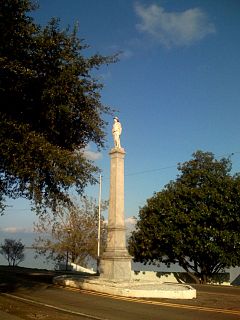
The Lake Village Confederate Monument is located on the median of Lakeshore Drive, between Main and Jackson Streets in Lake Village, Arkansas. The marble monument depicts a Confederate Army soldier standing in mid stride with his left foot forward. His right hand holds the barrel of a rifle, whose butt rests on the monument base. He carries a bedroll draped over his left shoulder, and wears a Confederate cap. A cannon that served as a fountain was once part of the sculpture, but is now missing. The statue is about 6 feet (1.8 m) high and 2 feet (0.61 m) square; it rests on a marble foundation that is 20 feet (6.1 m) long, 12 feet (3.7 m) wide, and 8 feet (2.4 m) high. The monument was erected in 1910 by two chapters of the United Daughters of the Confederacy at a cost of about $3,000.

The Camden Confederate Monument, also known as the Confederate Women's Memorial, is located on the grounds of the Ouachita County Courthouse in Camden, Arkansas. The sculpture, carved out of Italian marble, depicts a woman dressed in the period of the American Civil War, standing with her feet together, clutching a flagpole. The sculpture is mounted on a block of North Carolina granite, next to a tall obelisk. The statue is 5 feet (1.5 m) tall. The obelisk is inscribed on three sides, recognizing the valor of women in the Confederate cause, and the organizations that funded the memorial's construction. The memorial was erected in 1914 by the local chapters of the United Confederate Veterans and the United Daughters of the Confederacy.

The Robert E. Lee Monument is a U. D. C. memorial built to honor Lee County's Confederate veterans. The monument was carved by the McNeel Marble Co. It is located in Marianna, Arkansas, across from the Lee County Courthouse. Dedicated in 1910, it is one of several monuments built to honor Confederate soldiers. The structure is a local tourist attraction and, since 1996, has been listed in the National Register of Historic Places.
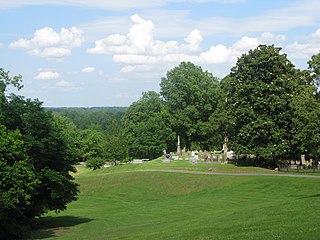
The Helena Confederate Cemetery is located in the southwest corner of the Maple Hill Cemetery on Holly Street in Helena, Arkansas. It is a small section of the larger cemetery, under one acre in size, and is marked by two significant memorials: the Confederate Memorial and the memorial to Confederate Army General Patrick Cleburne, whose burial here is the only known place associated with his life. The Cleburne memorial is a marble shaft 15 feet (4.6 m) in height, topped by an urn with flames coming from its top. The Confederate Memorial is a marble depiction of a soldier, mounted on a 30-foot (9.1 m) granite shaft, surrounded by pyramids of cannonballs and inverted cannons. The cemetery has more than 100 marked graves, 15 of which are unidentified Confederate dead, and 23 are of those killed in the 1863 Battle of Helena.

Maple Hill Cemetery is located on Holly Street, north of the center of Helena, Arkansas. It is set on 37 acres (15 ha) of land on the east side of Crowley's Ridge, overlooking the Mississippi River, and is the city's largest cemetery. The cemetery was established in 1865, and is laid out in the rural cemetery style which was popular in the mid-19th century. It departs from the norms of this style in retaining a largely rectilinear layout despite having parklike features. The cemetery's entrance is through an elaborately-decorated wrought iron archway, whose posts were given in 1914, and whose arch was given in 1975. The largest monument in the cemetery is the Coolidge Monument, placed by Henry P. Coolidge on the family plot, which is at the highest point of section 3; the monument is a granite column 21 feet (6.4 m) in height, with a life-size sculpture of Coolidge on top.

The Ft. Smith Confederate Monument stands on the grounds of the Sebastian County Courthouse at the junction of 6th and Rogers Streets in Fort Smith, Arkansas. The statue depicts a Confederate Army soldier, standing facing north, holding the upper stock of his rifle, which is grounded. The sculpture is 6 feet (1.8 m) in height, and is mounted on a square columnar pedestal over 30 feet (9.1 m) tall. The monument was placed in 1903 with funding raised by the local chapter of the Daughters of the Confederacy. An earlier Confederate memorial, placed at Fort Smith National Cemetery, was destroyed by a tornado, and the federal government objected to the placement of this memorial there without alterations to also commemorate the Union dead. The city granted permission for its placement at its current location.
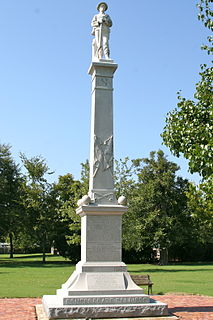
The Jackson Guards Memorial is a sculpture commemorating the Jackson Guards, a unit of the Confederate Army, in Arkansas's Jacksonport State Park. The sculpture stands at Washington and Avenue Streets in the park, and depicts a standing male soldier, holding with both hands a rifle, butt on the ground. The marble sculpture is about 6 feet (1.8 m) tall, and is mounted on a granite base 20 feet (6.1 m) tall and 10 feet (3.0 m) square. Funding for the statue was raised by private subscription, and it was unveiled in 1914 in Newport, the county seat of Jackson County. It was moved to its present location in 1965.

The Pine Bluff Confederate Monument has long been located in front of the Jefferson County courthouse, at Barraque and Main Streets in Pine Bluff, Arkansas. It depicts a standing Confederate Army soldier, holding a rifle whose butt rests on the ground. The statue, built out of Georgia marble by the McNeel Marble Company, stands on a stone base 15 feet (4.6 m) in height and 10 by 10 feet at the base. It was placed in 1910 by the local chapter of the United Daughters of the Confederacy.

The Memorial to Company A, Capitol Guards was an American Civil War memorial in MacArthur Park, Little Rock, Arkansas. It stood just northeast of the former Tower Building of the Little Rock Arsenal, at a junction of two of the park's internal roadways. It consisted of a bronze sculpture depicting a Confederate Army soldier in a defensive stance, holding a rifle pointed forward. The statue was 8 feet (2.4 m) in height, and was mounted in a granite column 16 feet (4.9 m) tall. The memorial was sometimes known as "Lest we forget", a line that appeared near the top of the inscription on the base. The statue was created by sculptor Rudolph Schwarz, and was installed in 1911; it was paid for by the local chapter of the Sons of Confederate Veterans, and memorializes the unit that seized the arsenal at the outset of the war.
The Tui Manu'a Graves Monument is a funerary marker and grave site on the island Ta'u, the largest island of the Manu'a group in American Samoa. It is located northwest of the junction of Ta'u Village and Ta'u Island Roads on the west side of the island. It consists of a stone platform, about 3 feet (0.91 m) in height, that is roughly rectangular in shape with a projection at one end. Three graves are marked by square sections of smoothed stones, while a fourth is marked by a marble column. A possible fifth grave, unmarked, is in the projection. It is the burial site of several tu'i, or kings, of Manu'a, including Tui Manu'a Matelita and Tui Manu'a Elisala, the Samoan leader whose signature granted the United States hegemony over the islands.

The Monument to Confederate Women, also known as the "Mother of the South", is a commemorative sculpture on the grounds of the Arkansas State Capitol in Little Rock, Arkansas. It depicts a mother and two of her children saying goodbye to an older son who is dressed in a Confederate uniform. The sculpture is cast in bronze, and stands over 7 feet (2.1 m) in height. It is mounted in a multi-tiered pedestal, nearly 12 feet (3.7 m) in height, with sections made of concrete, granite, and marble. The statue was created by J. Otto Schweizer, and was dedicated in 1913. It was funded by the United Confederate Veterans.





















